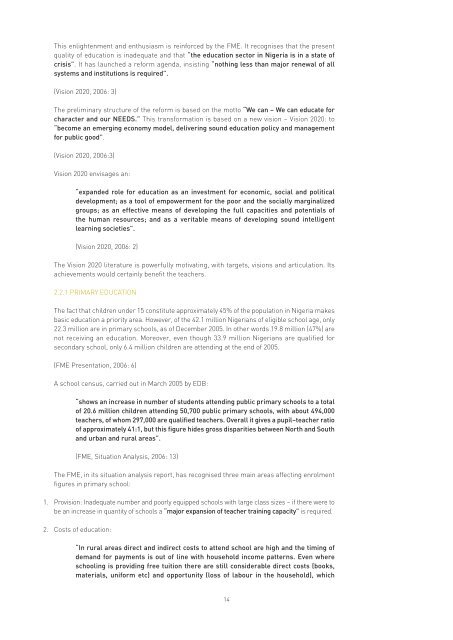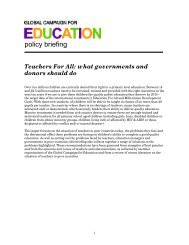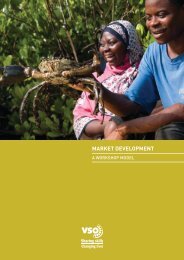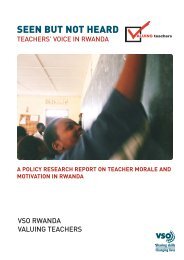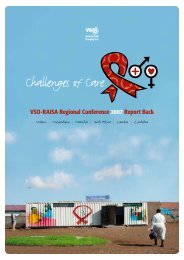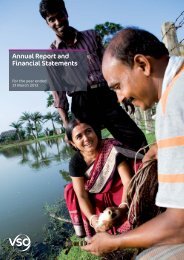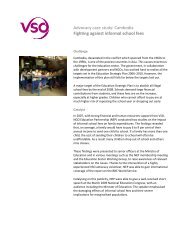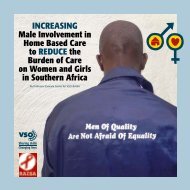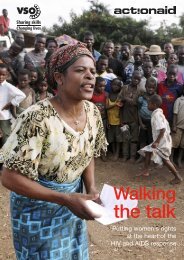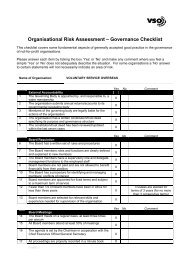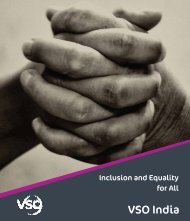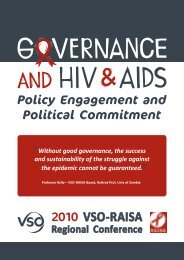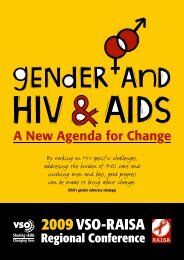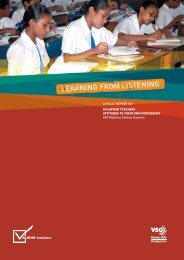Teachers' Voice â Nigeria - VSO
Teachers' Voice â Nigeria - VSO
Teachers' Voice â Nigeria - VSO
- No tags were found...
You also want an ePaper? Increase the reach of your titles
YUMPU automatically turns print PDFs into web optimized ePapers that Google loves.
This enlightenment and enthusiasm is reinforced by the FME. It recognises that the presentquality of education is inadequate and that “the education sector in <strong>Nigeria</strong> is in a state ofcrisis”. It has launched a reform agenda, insisting “nothing less than major renewal of allsystems and institutions is required”.(Vision 2020, 2006: 3)The preliminary structure of the reform is based on the motto “We can – We can educate forcharacter and our NEEDS.” This transformation is based on a new vision – Vision 2020: to“become an emerging economy model, delivering sound education policy and managementfor public good”.(Vision 2020, 2006:3)Vision 2020 envisages an:“expanded role for education as an investment for economic, social and politicaldevelopment; as a tool of empowerment for the poor and the socially marginalizedgroups; as an effective means of developing the full capacities and potentials ofthe human resources; and as a veritable means of developing sound intelligentlearning societies”.(Vision 2020, 2006: 2)The Vision 2020 literature is powerfully motivating, with targets, visions and articulation. Itsachievements would certainly benefit the teachers.2.2.1 PRIMARY EDUCATIONThe fact that children under 15 constitute approximately 45% of the population in <strong>Nigeria</strong> makesbasic education a priority area. However, of the 42.1 million <strong>Nigeria</strong>ns of eligible school age, only22.3 million are in primary schools, as of December 2005. In other words 19.8 million (47%) arenot receiving an education. Moreover, even though 33.9 million <strong>Nigeria</strong>ns are qualified forsecondary school, only 6.4 million children are attending at the end of 2005.(FME Presentation, 2006: 6)A school census, carried out in March 2005 by EDB:“shows an increase in number of students attending public primary schools to a totalof 20.6 million children attending 50,700 public primary schools, with about 494,000teachers, of whom 297,000 are qualified teachers. Overall it gives a pupil–teacher ratioof approximately 41:1, but this figure hides gross disparities between North and Southand urban and rural areas”.(FME, Situation Analysis, 2006: 13)The FME, in its situation analysis report, has recognised three main areas affecting enrolmentfigures in primary school:1. Provision: Inadequate number and poorly equipped schools with large class sizes – if there were tobe an increase in quantity of schools a “major expansion of teacher training capacity” is required.2. Costs of education:“In rural areas direct and indirect costs to attend school are high and the timing ofdemand for payments is out of line with household income patterns. Even whereschooling is providing free tuition there are still considerable direct costs (books,materials, uniform etc) and opportunity (loss of labour in the household), which14


